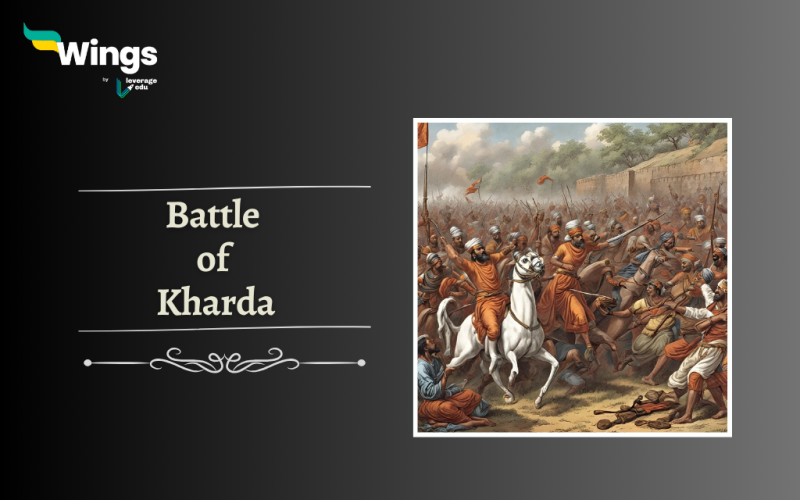The Battle of Kharda was fought between the Nizam of Hyderabad and the Maratha Empire. It was fought on 11th March 1795 at Kharda present-day district of Ahmednagar in Maharashtra. The battle was won by the Maratha forces who gave a befitting reply of their dominance and control over the region of the Indian Subcontinent to the British forces. Moreover, the Britishers refused to assist the Nizams despite being protected under them, which led to many Princely States to reconsider their current arrangements with the British. In this blog, let us get to know more information about the background, events and outcomes of the battle of Kharda.
Table of Contents
| Battle of Kharda Overview | |
| Battle Took Place On | 11th March, 1795 |
| Place | Kharda, Ahmednagar District of Maharashtra |
| Fought Between | Nizam of Hyderabad Vs Maratha Empire |
| Won By | Maratha Empire |
Background of the Battle of Kharda
The battle was important as it was the last battle that the Maratha Confederacy fought as a united force. The battle was held because of –
- The Nizams of Hyderabad and the Marathas previously had joined hands to fight against Tipu Sultan of Mysore.
- However, there remained some unresolved issues about the taxes levied by the Maratha Empire named Sardeshmukhi and Chauth, which created an environment of tension between the two allies.
- The Marathas sent under the leadership of Nana Phadnavis envoys two of their convoys to the Nizama’s court in 1791. The envoys were Govindao Pingle who was the head of the Maratha delegation, and Govindao Kale who was the leader of the Maratha forces.
- The two envoys urged the Nizam to negotiate with them once the war against Tipu Sultan was over. The two parties waited for two years before proceeding to the negotiations.
- The Nizam made a U-turn in the negotiations and claimed that the Maratha people owed him Rs. 2.5 lakhs. He also asked the officials of the British Eastern India Company (formed on December 31, 1660) to act as the arbitrators in the matter.
- In the meantime, Nizam’s army grew from 2 to 23 Battalions. This enraged the Maratha people.
- The negotiations continued until 1794, by which time both sides realised that the talks were futile. Neither side was budging on their demands.
Event of the Battle
Mir Nizam Ali Khan (Asaf Jah ill), the Nizam was prepared and had 45,000 infantry, 45,000 cavalry and 100,000 pieces of cannon.
- Sawai Madhav Rao Peshwa and Nana Phadnavis headed the Maratha Confederacy. The whole Maratha confederacy joined forces against the Nizams.
- The Holkar, Shinde, Gaekwad and Bhonsale were the ones who supported the Peshwa in the battle. Together they had 1,00,000 men and 100 cannons.
- In January 1795, Nizam’s army marched from Bidar. The battle took place near Kharda fort.
- The Maratha army followed the route through Aurangabad and Bidar to reach the Wakigungs and Paijiri.
- An advance party under Baburao Phadke was sent to capture the Nizam near the Mori Pass at Kharda, but the Nizam managed to escape with heavy losses.
- The Nizam then retreated to Kharda, pursued by the main army. The commander in chief of the Maratha army, Parshuram Bhau Patwardhan, was joined by Shinde, Holkar’s and Bhosale’s contingents.
- Soon, a battle between the Nizams and Marathas broke out near Kharda. The battle lasted all day before both armies withdrew for the night.
- The Marathas then played their ultimate game. In the darkness, they charged the Nizam, who had thought there was nothing to be feared. Scores of his men were slaughtered, and the Nizam was forced to retreat to the small fort at the Kharda.
- The Marathi army laid siege to Kharda fort and after 17 days of fighting, the Nizam finally gave up.
Also Read – Battle of Assaye: Background, Events & More
Outcome of the Battle
- The Nizam sent a dagger and a seal to signify that he was willing to accept whatever conditions were imposed on him. The Peshwa responded by stamping his seal on this final triumph.
- The Peshwa began by inquiring about Mushir ul Mulk, who had offended Nana Phadnis with his harsh remarks. The Nizam objected but finally gave in.
- His minister, the immediate instigator of the war, was taken to Pune and was confined as a prisoner.
- The Nizam gave up all the lands from Paranda Fort to Tapti River, as well as the fort of Daulatabad and the territories that had been occupied by the Sadashivrao Bhau in 1760.
- A tribute of 3 crores and 10 lacs was received from the Nizam.
- 29 lac was apportioned separately to Raghuji Bhosale.
- And land valued at 3.00,000 per annum was also apportioned to him.
FAQs
The battle of Kharda was fought on March 11, 1795. The Maratha Empire defeated the Hyderabad Nizam in a decisive battle.
The battle of Palkhed took place on February 28, 1728, in the village of Palkhed, close to the city of Nashik, in present-day Maharashtra, India. The battle was fought between the Maratha Empire, led by the Maharaja of Maharashtra, and the ruler of Hyderabad, Asaf Quli. The Maratha defeated the ruler of Nizam ul-Mulk.
The Maratha Empire was a large empire that covered a large part of what is now India in the 17th and 18th centuries. The Maratha Empire was formally established in 1674 as the Maratha Rajput State by the coronation of the Maharaja of Chattrapati, Shivaji. In 1818, the Maratha Empire came to an end with the defeat of the Peshwa of the Maratha Empire, Bajirao, at the hands of the British East India Company.
Relevant Blogs
This was all about the Battle of Kharda. For more content related to the different states of India, visit our articles like this, you can get Study notes on the Modern History of India here. Also, you can visit our general knowledge page on Indian History!
 One app for all your study abroad needs
One app for all your study abroad needs













